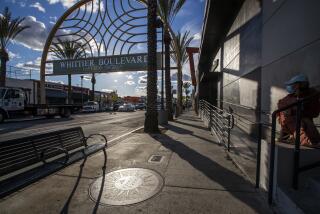Thousand Oaks as They Knew It
As part of the city’s 40th anniversary celebration, Thousand Oaks threw a large block party Tuesday evening and invited more than 400 of its original residents to participate in the festivities.
The occasion was a class photo of sorts. Residents who lived in the east Ventura County city before its incorporation in 1964 were invited to have their picture taken at the Civic Arts Plaza for the history books.
Mayor Bob Wilson Sr., a 33-year resident, addressed the crowd that squeezed into the plaza’s Kavli Theater for the photo. Wilson thanked them for helping to build their city, known for safe streets, clean industry and good schools.
“Our city is what it is today because of the work of you early residents,” said Wilson, 56. “You spoke loudly and clearly. You told the council what you wanted to see in the city and they listened.”
Following the session, the group stepped into the lobby for a reception. The council later issued a proclamation to mark the occasion.
Prior to the event, several residents spoke of their recollections of the city, now the second largest in the county with more than 117,000 people.
“We didn’t realize there were that many of us left,” said Jim Iriguchi, 72, who was among the community’s first dentists in 1962. He called Thousand Oaks “a country-type town that was very neighborly” when it began and said good planning has helped it grow at a comfortable pace.
Filmmaker Michael Hagopian, 90, who moved to the Conejo Valley in 1963, was looking forward to seeing old friends.
“People want to get back together. They’re interested in seeing each other. They like the town they live in,” he said. “The city has gotten larger and has lost some of its flavor, but it’s still a good place.”
Hagopian was on a 100-member committee that helped set goals for the city’s initial General Plan and was the first president of the Conejo Valley Historical Society that formed in 1964 to save the Stage Coach Inn, which the state had slated for demolition to build the Ventura Freeway.
Hagopian, whose wife, Antoinette, helped organize Tuesday’s celebration, remembered how the approximately 20,000 people who called Thousand Oaks home in the early ‘60s sought to incorporate to prevent the sprawl seen in neighboring Los Angeles.
Like several others, Hagopian discovered Thousand Oaks while on a drive to Santa Barbara and decided it was a good place to settle. It was also affordable. But times have changed. Homes that originally cost less than $20,000 in the 1960s now sell for more than $500,000, while large-lot residences now command upward of $950,000.
Engineer Frank Lussier, 62, said he arrived in 1963 to help design a building for Northrop in Newbury Park. He described the town as a rural outpost.
“I think there was only one traffic signal. There were still horses going up and down T.O. Boulevard,” he said. “It was a quiet little place.”
Fred Carlson, 84, said he arrived in 1946, after serving in the Navy, to start his own concrete-block manufacturing business. Back then, the population was closer to 500 and people still lived in tents along Thousand Oaks Boulevard, he said.
In 1949, Carlson spent $5,500 to buy a lot and build his first home in town. He drew up the plans on a piece of butcher paper, he said, and it cost only $3 for the building permit.
“People ask you, ‘Why didn’t you buy up the whole town?’ But there was no water, no gas and no electricity” to most sites where neighborhoods later sprang up, he said. “And the roads were dirt. They weren’t blacktop.”
Lynn Angell, whose family moved from Minnesota in May 1964, remembers thinking they had relocated to a big farm town.
At incorporation, there were four community parks, 10 acres of preserved open space and an abundance of ranchland. Today, the city is surrounded by nearly 15,000 acres of open space.
Angell, who has drawn computerized maps as a city employee for the past five years, said she has moved away several times in the past four decades but always returns to Thousand Oaks.
“I’ve gone away, traveled to England and back, and now I’m only a block away from where I started,” said Angell, 53. “People who have lived in Thousand Oaks always said that there’s a draw here. You may leave, but you always come back.”
More to Read
Sign up for Essential California
The most important California stories and recommendations in your inbox every morning.
You may occasionally receive promotional content from the Los Angeles Times.










